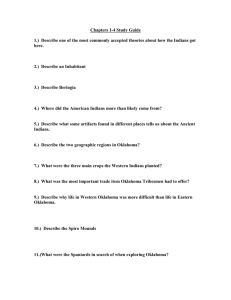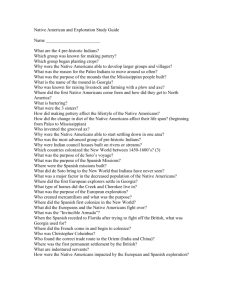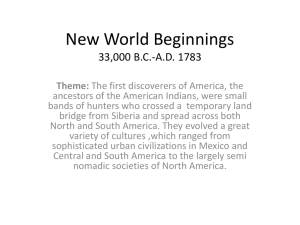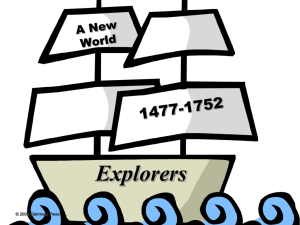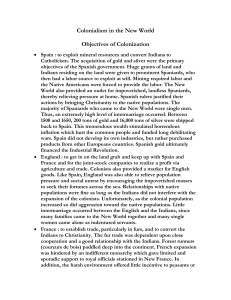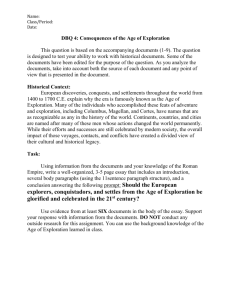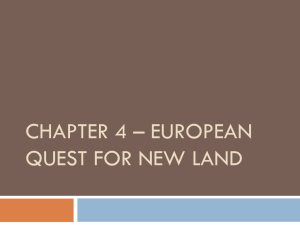Hyperlink Text
advertisement
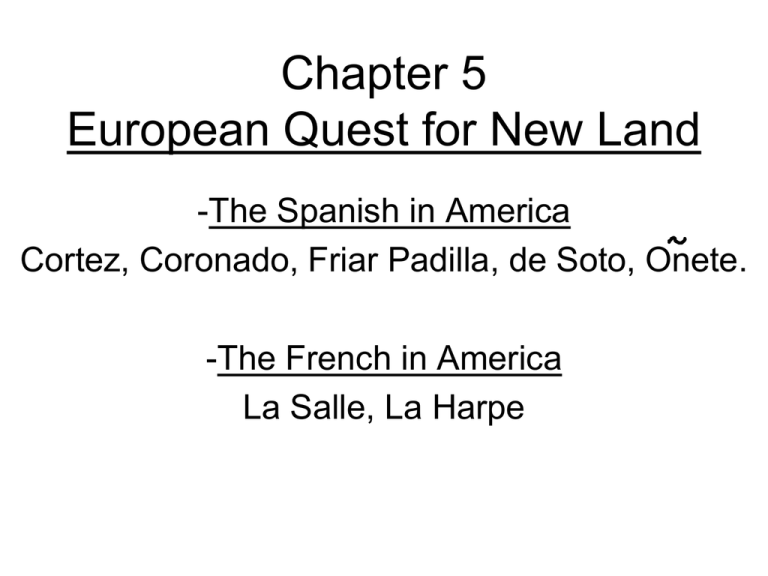
Chapter 5 European Quest for New Land -The Spanish in America Cortez, Coronado, Friar Padilla, de Soto, Onete. -The French in America La Salle, La Harpe Cortez • In Latin America, Cortes had defeated the Aztec nation by capturing one man, Montezuma, their god-king. • The Spaniards assumed that all Indians were ruled by the same type of government as the Aztecs. – The “god-king” concept of the Aztecs was that one ruler ruled many clans and segments of the mighty nation. – Therefore they failed to control the Indians to the north, even after defeating them in battle. Fernando Cortez Montezuma Aztec Temple Coronado • In 1540, Don Antonio de Mendoza, “the good viceroy,” had been appointed by Spanish Emperor Charles V (5th) to rule New Spain. • Mendoza sent the Spanish cavalry under the command of Coronado into the unknown north country to search for gold. • Because Spain was the most powerful nation in Europe, even in the world. The conquistadors believed they were invincible… which they were. • And they considered all strangers their enemies. Cortez • In the north not only did separate tribes have their own chiefs, but most tribes had several chiefs. • The religions and governments of northern Indians were diverse, and each tribe was a separate nation. • The Spaniards did not come prepared to deal with that situation. – They did not bring nearly enough men to control hundreds of “kingdoms” Don Francisco Vasquez de Coronado Don Antonio de Mendoza Coronado • Mendoza was confident that Coronado and his army would find and conquer the fabled Seven Cities of Cibola. • It was said that common utensils there were made from gold and that jewelstudded houses were built many stories high. • The Conquistadors were looking for the “3-G’s”… Gold, Glory for Spain, and God. Coronado • Had the Spaniards been less powerful and more friendly, history might have set quite a different course, for after crossing Oklahoma and turning west, the army did find the famous cities. – From a distance the houses, well-fashioned pueblos built several stories high, sparkled as though weighted down with precious jewels. • Greedy for gold, the Spanish army attacked and defeated the settlement, only to find that their “jewels” were nothing more than gypsum glistening in the sun. • The conquering Spaniards found a little silver, some fine clay pottery, and a few trinkets. • They found no gold. Coronado • Coronado and his men defeated all the cities. Coronado hoisted the flag of Spain and claimed new territory for the emperor. – He recorded what he had seen in places no other white man had traveled. – He found food and salt in Indian storehouses. – He sent out scouting parties that explored the Little Colorado River and found the Grand Canyon. – He executed many of the people he had conquered. – For a year, Coronado and his men moved back and forth across the plains and mesas, fighting and searching. – They never found gold. In the spring of 1542, they returned to Mexico. How did Coronado Defeat the Indians??? • The Spaniards defeated the inhabitants of Cibola with relative ease. • They had three distinct advantages — the horse, the gun, and the wagon. – They were able to ride in and attack and to flee swiftly because of their horses. – The Spanish guns made death much more certain at greater distances than the Indians’ arrows and stones. – With their “rolling boxes”, the Spaniards were able to carry necessary ammunition, food and other items for life and defense wherever they went. – These items bore the element of surprise against an otherwise able enemy and left the Indians at the mercy of the Spanish Conquistadors. Friar Juan de Padilla • Coronado had traveled across part of Oklahoma and western Kansas and had found a Wichitatype village inhabited by a tribe of tattooed farmers. • Friar Juan de Padilla, a chaplain with the expedition, decided to return there when Coronado’s army returned to Mexico. – Padilla wished to establish a mission for the tribe. He was accompanied by Andres de Campo, a Portuguese soldier. • They ministered to the tattooed people during most of 1542 and then traveled back through central Oklahoma to visit another tribe. – En route, they were attacked by a hostile tribe, and Padilla died Friar Juan de Padilla • After being held captive for over a year, Andres do Campo and 2 other soldiers escaped. • As they made their way back to the Gulf of Mexico, they carried a heavy wooden cross as a tribute to Friar Padilla. – This took these men 5 years! • The route they took through central Oklahoma and Texas was then used by Spanish officials as the main way to get to their northern lands, they called it the “trail of the cross” and it matches up with present day Interstate 35. SPANISH LEGACY • When they departed, the Spaniards left a legacy of distrust, hatred, and violence. – Most important, however, they left horses. • Nothing changed the life of the western tribes as did the horses. – Hunting was easier from horseback. – The use of horses made them more powerful in warfare, just as they had made the Spaniards too powerful to defeat. – Horses soon became the mark of wealth among those tribes. • Two hundred years later, when white men again encountered the western Indians, their horses made them more formidable foes than Coronado had faced. HERNANDO DE SOTO • Other animals brought for the first time into North America by the Spaniards were pigs, goats, sheep, cattle, and chickens. • Hernando De Soto brought many of them because he didn’t know if sufficient food would be available to feed his army. • De Soto had been sent to the New World to conquer Florida, and the Spanish emperor had made him governor of Cuba and Florida. Hernando de Soto HERNANDO DE SOTO • De Soto’s army expected to find wealth in Florida similar to the jewels and precious metals found in South America by Cortes. • When they failed to find what they were seeking, they pushed on into the interior of the country. – They fought the Choctaws in the Mississippi Valley and continued westward. • They crossed the Mississippi River in May, 1541, and pressed onward. • De Soto’s private secretary, Rodrigo Ranjel, kept the official record of their journey. HERNANDO DE SOTO • When the army reached the Grand and Arkansas River valleys in eastern Oklahoma, he recorded details of what they saw. • He wrote about “wild cows” that the Indians killed and about how the “cow skins” were used in many different ways. • He described the complicated stockades which protected many Indian towns and villages. • He told of elaborate temples in which complex rituals were performed. • He told of friendly native people wearing beautiful clothes and adornments of shell and pearl. • These inhabitants guided them through the wilderness from place to place, until the Spaniards made it plain they considered the natives as nothing more than beasts to be chased by their dogs. HERNANDO DE SOTO • Finally, tired of being mistreated and robbed, the Indians became hostile toward De Soto and his men. • The Spaniards, at last convinced that they would find no gold, turned back to the Mississippi River, where De Soto died of an illness (fever) on May 15, 1542. – Half of his original force survived to return to Panuco, Mexico, by following the river south. • Controversy has arisen as to whether De Soto actually came within the borders of present-day Oklahoma. • Ranjel’s (his recordkeeper) writings seem to indicate, however, that the expedition reached the Arkansas River and perhaps came even further into the eastern part of the state. Don Juan de Onate • The last major Spanish expedition into Oklahoma was led by Don Juan de Onate in 1601. – Again it was a search for gold. • Taking artillery carts and more than 700 horses and mules, Onate and his men followed the San Buenaventura (Canadian) River to the Antelope Hills in the western part of the state. • They marched northward into Kansas and on to the country of the tattooed people. • The Quivira, or tattooed people, probably lived near the location of what is Wichita, Kansas, today Don Juan de Onate • Upon their arrival, Onate’s army was attacked vigorously by the Quivira, who had greeted Coronado quite placidly 60 years earlier. – The fight was so violent that most of the Spaniards were injured and forced to return to their encampment on the Rio Grande. • Although he was not interested in it as a prize, Onate recorded the beauty of the Great Plains, the huge herds of buffalo which grazed upon it, and the remarkable fruits and grasses he saw growing there. The Frenchies… La Salle and La Harpe • Just as the Spanish came to seek their fortunes in the new land, so did the French — but the French did not want to conquer. – The French wanted to trade, and to trade for furs in particular. • Robert Cavalier, Sieur de la Salle, never saw Oklahoma, but in 1682 he claimed the area for France. • He claimed not only the Mississippi River Valley, but the rivers which flowed to the Mississippi as well. • He named the area Louisiana in honor of the French ruler, King Louis XIV (14th) La Salle “This French Explorer, seeking trade with the Wichita Indians, came North from Louisiana on August 25, 1719. He camped 3 miles East of Hartshorne.” La Salle • The French sought peace and trade with the Indians, but their feelings toward the Spanish were not so friendly. • Louis XIV wrote in his memoirs that La Salle hoped to gain control of trade in Louisiana by securing two advantageous ports. • He particularly wanted one approximately sixty miles upriver from the Gulf on the banks of the Colbert (Mississippi) River. – In addition, by enlisting large native forces, supplemented by 400 or so French soldiers, the explorer planned to expel the Spaniards from the area. • La Salle was certain that the Indians’ hatred of the Spaniards would seal any necessary pact between the natives and the French. La Salle • Actually, La Salle’s plan might have worked had the French army not encountered so many misfortunes. – Lost in the wilderness, seeing their companions die from disease, and further weakened by desertions and Indian attacks, the French soldiers turned against their leader and killed him in his sleep. – The survivors returned to France and left dreams of New World control buried with La Salle. • Less political fur traders carried on the trade with the Indians, however, and in 1718, Bernard de la Harpe began trading along the Red and Arkansas Rivers. – He established no permanent trading post, but his records added to the knowledge of historians concerned with that time period. CULTURAL EXCHANGES • European-Indian contact began to cause change right away on both sides. Each contributed items to the other’s culture. • In addition to corn, beans, and squash, Indians introduced Europeans to pumpkins, avocados, pineapples, chewing gum, and chocolate. • The Europeans brought peas, pears, apricots and several other fruits the Indians had not tried. They also brought wheat, pigs, and horses. CULTURAL EXCHANGES • From the Europeans, the Indians learned metalcraft. • The Europeans taught them the art of metallurgy, heating metal and hammering it into a particular shape. • The Indians began to make a few farm implements and small household items. • Some tribes made beautiful silver jewelry, for which they are well-known today. • Prior to the coming of the Europeans, the Indians’ primary materials with which to make their tools and utensils were clay, wood, stone, and bone. “Don't touch that please, your primitive intellect wouldn't understand alloys and compositions and things with... molecular structures.” -Ash Williams CULTURAL EXCHANGES • For many years, Indians continued to trade with Europeans for most of the metal items needed, as they perfected their own crafts. – Like the whites, Indians wanted to own knives. • However, the most powerful metal item introduced to the Indians by Europeans was the gun. Gun trading was a lively, prosperous, and oftentimes law-breaking business for frontier traders. CULTURAL EXCHANGES • Most Indian tribes had some form of system by which the elderly and the disabled were supported. – No such system existed anywhere in Europe in the form of a government agency. • Sanitation and city planning were developed sciences among some Indian tribes. – These abilities account for the absence of certain diseases among the natives, or so some experts believe. • Europe, on the other hand, frequently suffered epidemics of various kinds which modern scientists attribute to the lack of proper sanitation. CULTURAL EXCHANGES • Perhaps the greatest surprise concerning Indian culture at the time of the Europeans’ first arrivals was the lack of a wheel. – In spite of their advanced technology in some areas, the American Indian had never developed the concept of the wheel. • Therefore, some of their technical advancement may have been hindered from the extensive growth that could have occurred with the use of mobile conveyances and other mechanisms made possible by the rolling disc.
